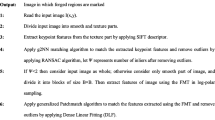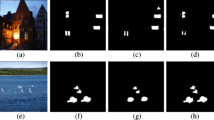Abstract
Keypoint-based and block-based methods are two main categories of techniques for detecting copy-move forged images, one of the most common digital image forgery schemes. In general, block-based methods suffer from high computational cost due to the large number of image blocks used and fail to handle geometric transformations. On the contrary, keypoint-based approaches can overcome these two drawbacks yet are found difficult to deal with smooth regions. As a result, fusion of these two approaches is proposed for effective copy-move forgery detection. First, our scheme adaptively determines an appropriate initial size of regions to segment the image into non-overlapped regions. Feature points are extracted as keypoints using the scale invariant feature transform (SIFT) from the image. The ratio between the number of keypoints and the total number of pixels in that region is used to classify the region into smooth or non-smooth (keypoints) regions. Accordingly, block based approach using Zernike moments and keypoint based approach using SIFT along with filtering and post-processing are respectively applied to these two kinds of regions for effective forgery detection. Experimental results show that the proposed fusion scheme outperforms the keypoint-based method in reliability of detection and the block-based method in efficiency.








Similar content being viewed by others
References
Achanta, R., Shaji, A., Smith, K., Lucchi, A., Fua, P., & Susstrunk, S. (2012). SLIC superpixels compared to state-of-the-art superpixel methods. IEEE Transactions on Pattern Analysis and Machine Intelligence, 34(11), 2274–2282.
Amerini, I., Ballan, L., Caldelli, R., Del Bimbo, A., & Serra, G. (2011). A sift-based forensic method for copy-move attack detection and transformation recovery. IEEE Transactions on Information Forensics and Security, 6(3), 1099–1110.
Amerini, I., Ballan, L., Caldelli, R., Del Bimbo, A., Del Tongo, L., & Serra, G. (2013). Copy-move forgery detection and localization by means of robust clustering with J-Linkage. Signal Processing: Image Communication, 28(6), 659–669.
Bashar, M., Noda, K., Ohnishi, N., & Mori, K. (2010). Exploring duplicated regions in natural images. IEEE Transactions on Image Processing. doi:10.1109/TIP.2010.2046599.
Bayram, S., Sencar, H. T., & Memon, N. (2009). An efficient and robust method for detecting copy-move forgery. In IEEE international conference on acoustics, speech and signal processing (pp. 1053–1056).
Bilmes, J. A. (1998). A gentle tutorial of the EM algorithm and its application to parameter estimation for Gaussian mixture and hidden Markov models. International Computer Science Institute, 4(510), 126.
Bo, X., Junwen, W., Guangjie, L., & Yuewei, D. (2010). Image copy-move forgery detection based on SURF. In 2010 international conference on multimedia information networking and security (MINES) (pp. 889–892). IEEE.
Cheng, G., Han, J., Guo, L., Liu, Z., Bu, S., & Ren, J. (2015). Effective and efficient midlevel visual elements-oriented land-use classification using VHR remote sensing images. IEEE Transactions on Geoscience and Remote Sensing, 53(8), 4238–4249.
Cheng, G., Han, J., Zhou, P., & Guo, L. (2014). Multi-class geospatial object detection and geographic image classification based on collection of part detectors. Isprs Journal of Photogrammetry and Remote Sensing, 98(1), 119–132.
Christlein, V., Riess, C., Jordan, J., Riess, C., & Angelopoulou, E. (2012). An evaluation of popular copy-move forgery detection approaches. IEEE Transactions on Information Forensics and Security, 7(6), 1841–1854.
Fischler, M. A., & Bolles, R. C. (1981). Random sample consensus: A paradigm for model fitting with applications to image analysis and automated cartography. Communications of the ACM, 24(6), 381–395.
Fridrich, J., Soukal, D., & Lukas, J. (2003). Detection of copy-move forgery in digital images. In Proceedings of digital forensic research workshop.
Han, J., Zhang, D., Cheng, G., Guo, L., & Ren, J. (2015a). Object detection in optical remote sensing images based on weakly supervised learning and high-level feature learning. IEEE Transactions on Geoscience and Remote Sensing, 53(6), 3325–3337.
Han, J., Zhang, D., Hu, X., Guo, L., Ren, J., & Wu, F. (2015b). Background prior-based salient object detection via deep reconstruction residual. IEEE Transactions on Circuits and Systems for Video Technology, 25(8), 1309–1321.
Huang, H., Guo, W., & Zhang, Y. (2008). Detection of copy-move forgery in digital images using SIFT algorithm. In Pacific-Asia Workshop on Computational Intelligence and Industrial Application, 2008. PACIIA’08 (Vol. 2, pp. 272–276). IEEE.
Huynh, T. K., Huynh, K. V., Le-Tien, T., & Nguyen, S. C. (2015). A survey on image forgery detection techniques. In 2015 IEEE RIVF International conference on computing and communication technologies—research, innovation, and vision for the future (RIVF).
Jiang, J., Kohler, J., Macwilliams, C., Zaletelj, J., Guntner, G., Horstmann, H., et al. (2011). LIVE: An integrated production and feedback system for intelligent and interactive TV broadcasting. IEEE Transactions on Broadcasting, 57(3), 646–661.
Jing, L., & Shao, C. (2012). Image copy-move forgery detecting based on local invariant feature. Journal of Multimedia, 7(1), 90–97.
Kang, X. B., & Wei, S. M. (2008).Identifying tampered regions using singular value decomposition in digital image forensics. In 2008 International conference on computer science and software engineering (pp. 926–930).
Khotanzad, A., & Hong, Y. H. (1990). Invariant image recognition by Zernike moments. IEEE Transactions on Pattern Analysis and Machine Intelligence, 12(5), 489–497.
Kumar, S., Desai, J., & Mukherjee, S. (2015). A fast keypoint based hybrid method for copy move forgery detection. International Journal of Computing and Digital Systems, 4(2), 91–99.
Li, Y. (2013). Image copy-move forgery detection based on polar cosine transform and approximate nearest neighbor searching. Forensic Science International, 224(1), 59–67.
Li, J., Li, X., Yang, B., & Sun, X. (2015). Segmentation-based image copy-move forgery detection scheme. IEEE Transactions on Information Forensics and Security, 10(3), 507–518.
Li, L., Li, S., Zhu, H., Chu, S. C., Roddick, J. F., & Pan, J. S. (2013). An efficient scheme for detecting copy-move forged images by local binary patterns. Journal of Information Hiding and Multimedia Signal Processing, 4, 46–56.
Lin, H.-J., Wang, C.-W., & Kao, Y.-T. (2009). Fast copy-move forgery detection. WSEAS Transactions on Signal Processing, 5(5), 188–197.
Lowe, D. G. (1999). Object recognition from local scale-invariant features. In The proceedings of the seventh IEEE international conference on computer vision (Vol. 2, pp. 1150-1-157). Ieee.
Lowe, D. G. (2004). Distinctive image features from scale-invariant keypoints. International Journal of Computer Vision, 60(2), 91–110.
Luo, W., Huang, J., & Qiu, G. (2006). Robust detection of region-duplication forgery in digital image. In 18th International conference on pattern recognition, 2006. ICPR 2006 (Vol. 4, pp. 746–749). IEEE.
Mahdian, B., & Saic, S. (2007). Detection of copy-move forgery using a method based on blur moment invariants. Forensic Science International, 171(2), 180–189.
Muhammad, N., Hussain, M., Muhammad, G., & Bebis, G. (2011). Copy-move forgery detection using dyadic wavelet transform. In Proceedings of the 2011 eighth international conference computer graphics, imaging and visualization (pp. 103–108).
Ng, T., Chang, S., Hsu, J., & Pepeljugoski, M. (2004). Columbia photographic images and photorealistic computer graphics dataset. ADVENT, Columbia University.
Popescu, A. C., & Farid, H. (2004). Exposing digital forgeries by detecting duplicated image regions. Computer Science Dartmouth College Private Ivy League Research University, 646.
Pun, C. M., Yuan, X. C., & Bi, X. L. (2015). Image forgery detection using adaptive over-segmentation and feature points matching. IEEE Transactions on Information Forensics and Security, 10, 1–1.
Ren, J., Jiang, J., & Vlachos, T. (2010). High-accuracy sub-pixel motion estimation from noisy images in Fourier domain. IEEE Transactions on Image Processing, 19(5), 1379–1384.
Ren, J., Zabalza, J., Marshall, S., & Zheng, J. (2014). Effective feature extraction and data reduction in remote sensing using hyperspectral imaging [Applications Corner]. IEEE Signal Processing Magazine, 31(31), 149–154.
Ryu, S. J., Lee, M. J., & Lee, H. K. (2010). Detection of copy-rotate-move forgery using Zernike moments. In R. Bohme, P. W. L. Fong & R. Safavi-Naini (Eds.), Information hiding (pp. 51–65). Berlin: Springer.
Ryu, S.-J., Kirchner, M., Lee, M.-J., & Lee, H.-K. (2013). Rotation invariant localization of duplicated image regions based on Zernike moments. IEEE Transactions on Information Forensics and Security, 8(8), 1355–1370.
Sencar, H. T., & Memon, N. (2008). Overview of state-of-the-art in digital image forensics. Algorithms, Architectures and Information Systems Security, 3, 325–348.
Shensa, M. (1992). Discrete wavelet transform: Wedding the a trous and Mallat algorithms. IEEE Transactions on Signal Processing, 40(10), 2464–2482.
Teh, C.-H., & Chin, R. T. (1988). On image analysis by the methods of moments. IEEE Transactions on Pattern Analysis and Machine Intelligence, 10(4), 496–513.
Tralic, D., Zupancic, I., Grgic, S., & Grgic, M. (2013). CoMoFoD—new database for copy-move forgery detection. In ELMAR, 2013 55th international symposium (pp. 49–54). IEEE.
Vedaldi, A., & Fulkerson, B. (2010). VLFeat: An open and portable library of computer vision algorithms. In Proceedings of the 18th ACM international conference on multimedia (pp. 1469–1472). ACM.
Wang, J., Liu, G., Zhang, Z., Dai, Y., & Wang, Z. (2009). Fast and robust forensics for image region-duplication forgery. Acta Automatica Sinica, 35(12), 1488–1495.
Zabalza, J., Ren, J., Wang, Z., Marshall, S., & Wang, J. (2014). Singular spectrum analysis for effective feature extraction in hyperspectral imaging. IEEE Geoscience and Remote Sensing Letters, 11(11), 1886–1890.
Zahra, M. (2012). Image duplication forgery detection using two robust features. Research Journal of Recent Sciences, 1(12), 1–6.
Zhao, C., Li, X., Ren, J., & Marshall, S. (2013). Improved sparse representation using adaptive spatial support for effective target detection in hyperspectral imagery. International Journal of Remote Sensing, 34(24), 8669–8684.
Acknowledgments
This study was supported by the Science and Technology Innovation Project of Shaanxi Province (Nos. 2015KTTSGY04-05 and 2015KTZDGY04-01), Pre-research Project: target detection project. The authors also wish to greatly thank the editors and anonymous reviewers for their constructive comments to further improve the clarity and quality of this paper. We also thank Li et al. (2015) for providing their source codes to enable us for more accurate performance assessment in term of not only precision, recall and F1 but also the running time.
Author information
Authors and Affiliations
Corresponding author
Rights and permissions
About this article
Cite this article
Zheng, J., Liu, Y., Ren, J. et al. Fusion of block and keypoints based approaches for effective copy-move image forgery detection. Multidim Syst Sign Process 27, 989–1005 (2016). https://doi.org/10.1007/s11045-016-0416-1
Received:
Revised:
Accepted:
Published:
Issue Date:
DOI: https://doi.org/10.1007/s11045-016-0416-1




